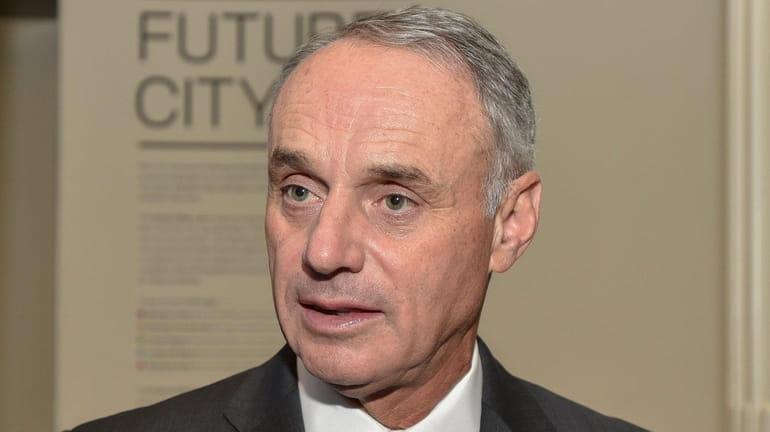Juiced baseballs? Rob Manfred denies they're doctored, but union disagrees

MLB commissioner Rob Manfred at the Museum of the City of New York's exclusive photo exhibit to begin the yearlong Jackie Robinson Centennial Celebration. Credit: Newsday /Howard Simmons
CLEVELAND — The Home Run Derby, as far as the sport’s high-flying baseballs are concerned, didn’t end with Pete Alonso’s thrilling victory Monday night at Progressive Field.
It continued Tuesday morning, in a downtown hotel ballroom, not far from the stadium. Only this time the combatants were commissioner Rob Manfred and union chief Tony Clark, as the pair took turns debating the perceived notion that this year’s baseballs have been intentionally doctored to increase offense.
Justin Verlander, the AL’s starting pitcher for Tuesday night’s All-Star Game, accused Manfred of doing exactly that in a scathing interview Monday with ESPN. The former Cy Young winner said, “Major League Baseball's turning this game into a joke.” And when asked if this was done on purpose, Verlander replied, "Yes. One hundred percent. They've been using juiced balls in the Home Run Derby forever. They know how to do it.”
Manfred refused to address Verlander’s comments directly in speaking at the Baseball Writers' Association of America meeting, as he didn’t want to get in a “public back-and-forth” with a player. But Manfred categorically denied the pitcher’s claims, repeatedly stressing MLB’s transparency regarding the ball’s production. MLB purchased Rawlings, the company that makes the baseballs, in June 2018.
“[MLB] has done nothing, given no direction for an alteration in the baseball,” Manfred said. “As a matter of fact, we commissioned an independent study to make clear that there has been no intentional alteration in the manufacturing process. The biggest flaw in that logic is that baseball somehow wants more home runs.
“If you sat in an owners meetings, and listened to people talk about the way our game is being played, that is not the sentiment among the owners for whom I work. There is no desire on part of ownership to increase the number of home runs in the game. To the contrary, they’re concerned about how many we have.”
MLB is on pace for 6,668 home runs this season, a total that would smash the record of 6,105 from 2017. Verlander has allowed an MLB-high 26 homers, and Clark mentioned that he’s heard plenty of other complaints.
“The game has changed, the ball is different,” Clark said. “The why? We haven’t gotten the why yet. Nobody seems to have represented the why yet. But there’s been an acknowledgement that it’s different, and that difference in part is yielding different results on the field. And so the question becomes, what are we going to do about it?
“It’s safe to say whether you’re a position player or a hitter, and there’s been dramatic changes suddenly in how the game is played and what balls are doing on the field, you’re going to ask questions — if for no other reason that our guys are historians, too. Our guys know and understand and respect their place in the historical conversation. How are those statistics represented? Those are valid questions and valid concerns.”
Clark said Manfred has told him the same things the commissioner has stated publicly, that the ball is being manufactured within the same specifications as always. But Clark also pointed out that other measures have been taken to affect the ball’s performance in the past, such as the introduction of a humidor at Coors Field in Denver. So does he believe the ball was manipulated on purpose?
“I believe that the ball suddenly changed,” Clark said. “And I don’t know why.”
This is hardly a new subject for Manfred, who has been interrogated on the baseballs since home runs first spiked during the 2015 season. Last month, Manfred referred back to the ’18 report, and explained that MLB’s scientific team advised him that the ball now had less drag, enabling it to fly farther. The reason for that? Manfred pointed to the “pill” — the round piece of cork at the core — as being more centered, causing the ball to wobble less in flight.
Another study, done by an astrophysicist for The Athletic, found that the ball’s seams were now thicker, tighter — and, as a result, lower. Also, the leather cover was smoother, another factor to lessen drag. Manfred attributed all of these developments to variations in the natural materials, as well as the fact that the ball is assembled by hand.
“First of all, I think you need to appreciate how small the variations are in the manufacturing process that can produce a change in the way the ball performs on the field,” Manfred said. “Number two, if you look at the report that was done, the balls that were being produced all fell within the specifications that we had in the manufacturing process. It wasn’t that they started making balls that were outside specs. I think the challenge for us is to get better control over that variation, tighten those specifications and get more comfortable with how the ball is going to perform year to year.”
Manfred also made sure to emphasize that the specifications are under discussion, based on the recent events. And he pledged to remain open about any baseball-related issue in the future.
“The only thing I can tell you, 100 percent, if we make a decision to change the baseball, you’re going to know about it before we change the baseball,” Manfred said. “Changing the baseball is a mechanism by which you manage the way the game is being played. We haven’t missed that idea. But if we were going to do it, we would do it in a way that was transparent to the media and the fans in advance of making that change.”

